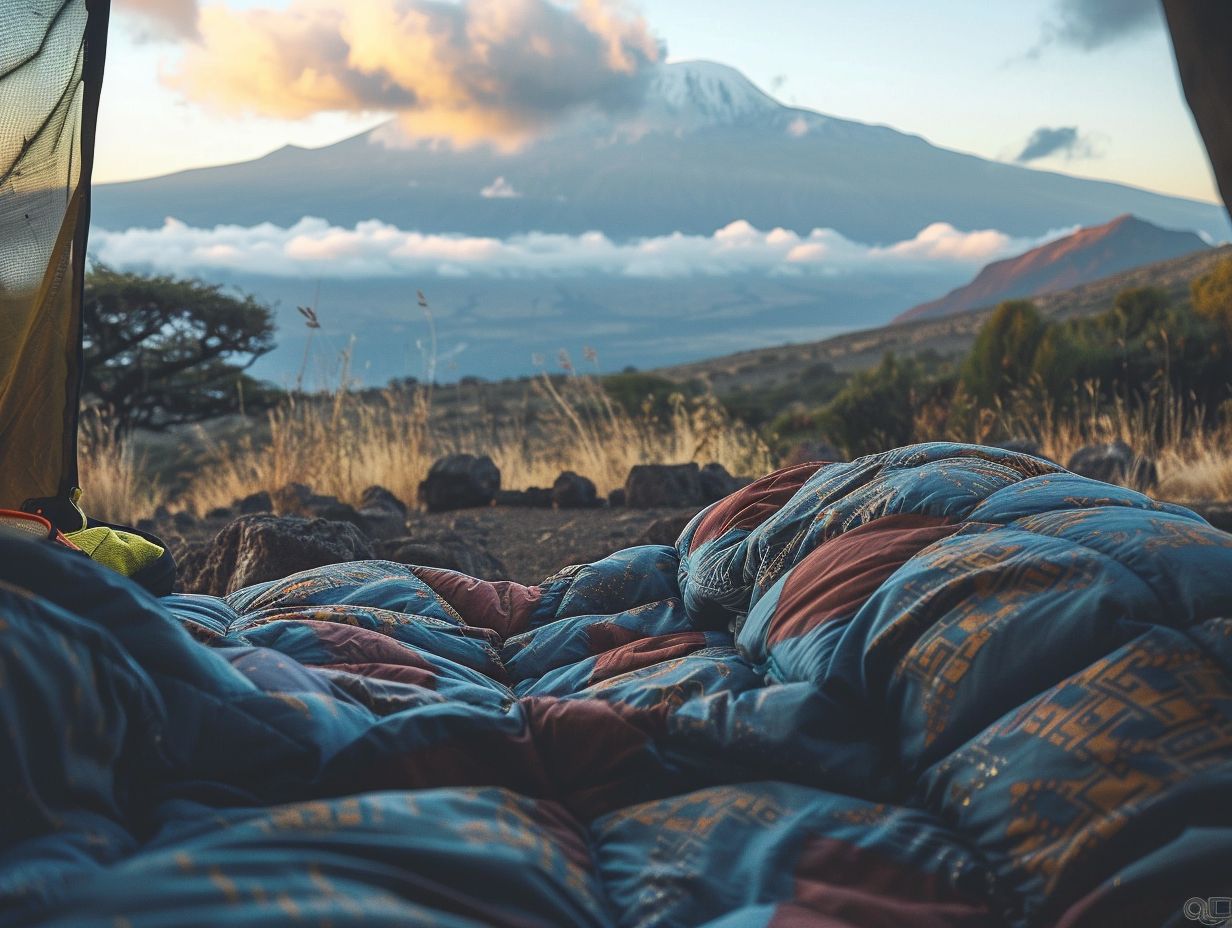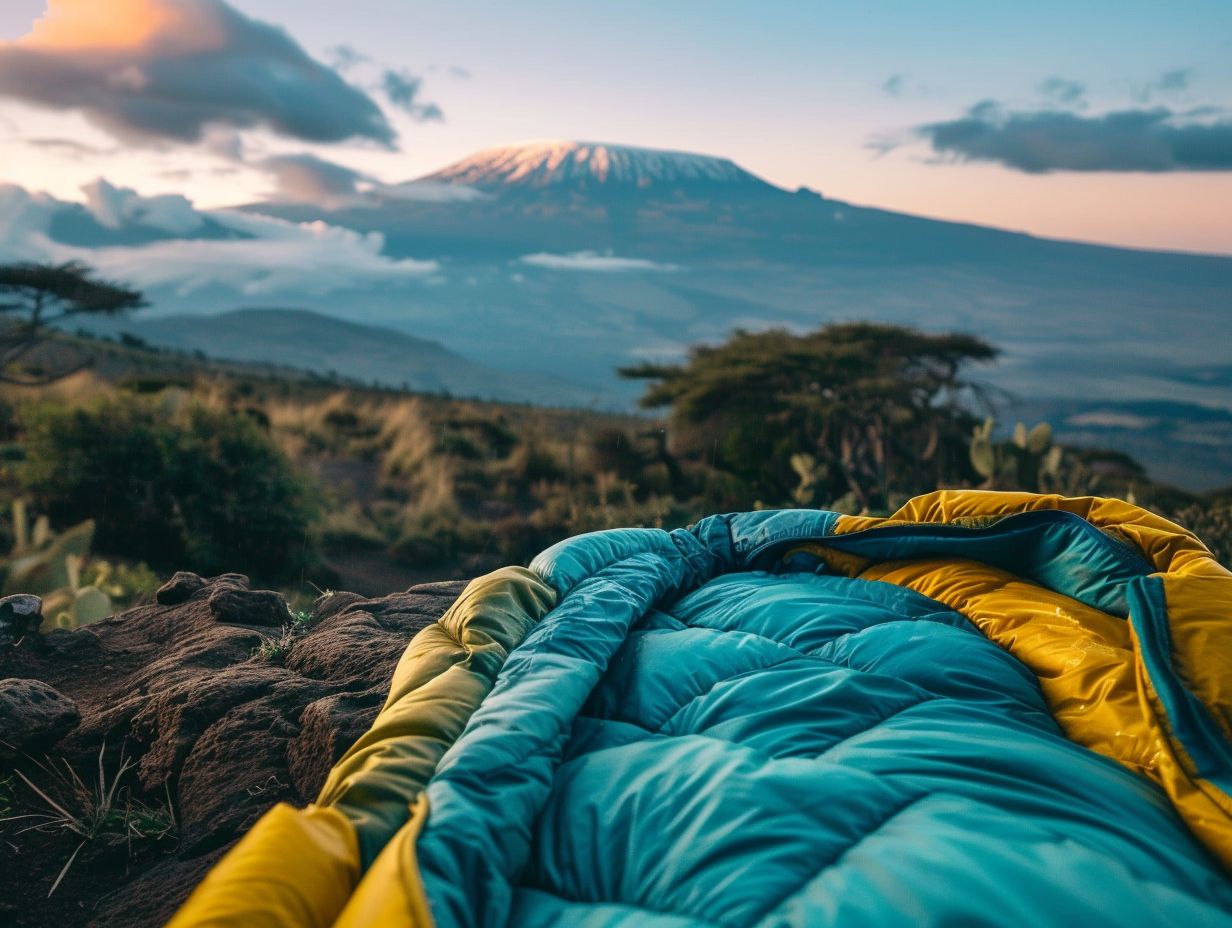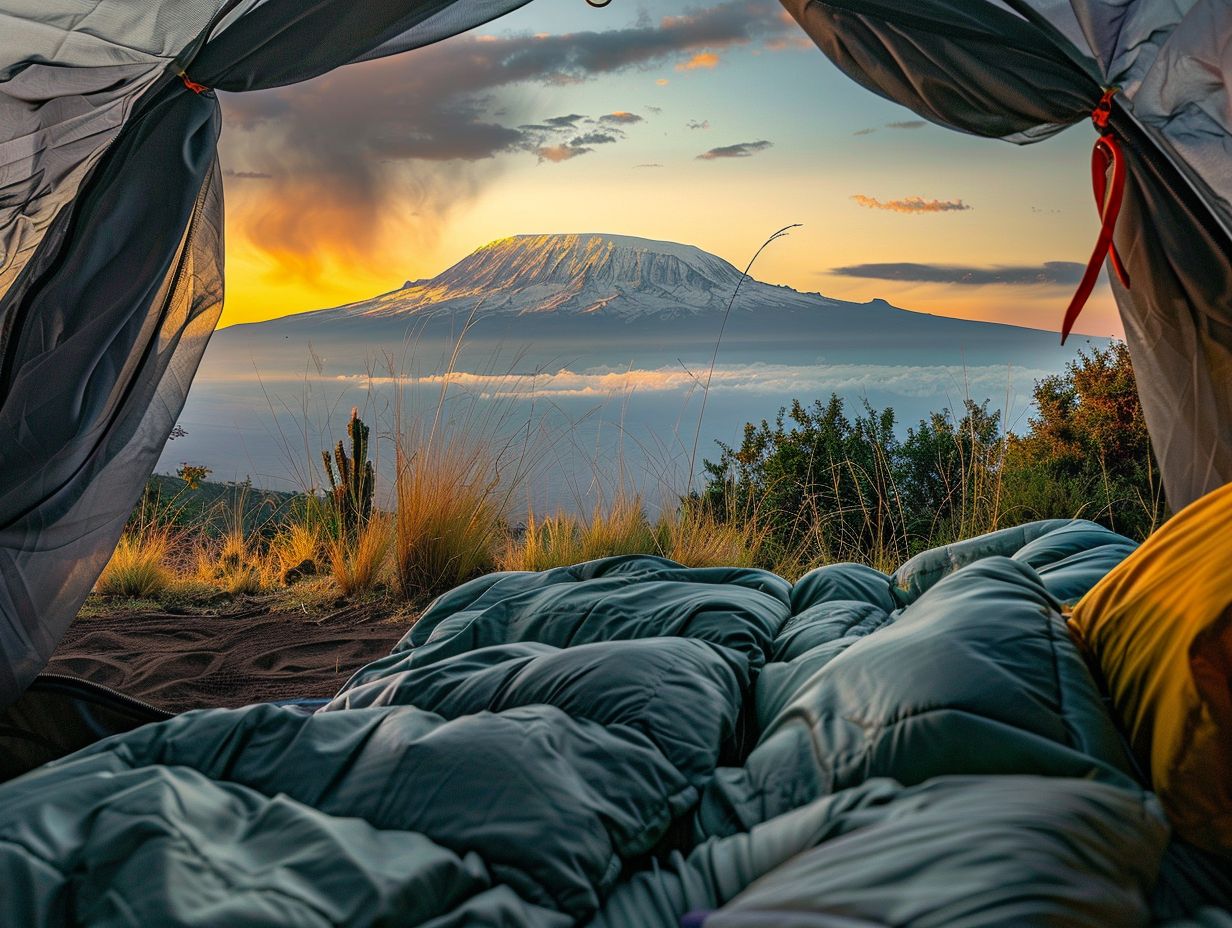
Sleeping Bag For Kilimanjaro
Planning a trek up Mount Kilimanjaro? One of the most important items to consider is your sleeping bag.
This article discusses the key factors to keep in mind when choosing a sleeping bag for Kilimanjaro, including temperature rating, weight, insulation type, and durability. We also explore the different types of sleeping bags available, the ideal temperature rating for Kilimanjaro, how to properly insulate your sleeping bag, and some tips for sleeping comfortably on the mountain.
Find the perfect sleeping bag for your Kilimanjaro adventure!
Key Takeaways:

- Choose a sleeping bag with a temperature rating of at least 0°F for Kilimanjaro’s cold climate.
- Consider the weight and portability of your sleeping bag, as you will have to carry it during your trek.
- Insulation type, shape, size, and durability are important factors to consider when selecting a sleeping bag for Kilimanjaro.
What to Consider When Choosing a Sleeping Bag for Kilimanjaro?
When selecting a sleeping bag for your Kilimanjaro adventure, it is crucial to consider various factors that can significantly impact your comfort and safety during the expedition.
One of the most critical factors to keep in mind is the temperature rating of the sleeping bag.as the climate can vary drastically, from hot and humid at lower altitudes to freezing temperatures at the summit. It is essential to choose a bag that can handle these extreme conditions.
The insulation type plays a vital role in keeping you warm. Down insulation is known for its exceptional warmth-to-weight ratio, while synthetic insulation performs better in wet conditions.
Weight is another key consideration, especially for long treks. Opting for a lightweight as well as a durable bag that won’t weigh you down is crucial. Look for materials like ripstop nylon or polyester to ensure longevity.
Don’t forget about sleep accessories such as a sleeping pad or liner to enhance insulation and comfort. By carefully evaluating these factors, you can ensure a restful and safe night’s sleep on your Kilimanjaro adventure.
1. Temperature Rating
The temperature rating of your sleeping bag is a critical consideration when preparing for your Kilimanjaro expedition, as it determines how well the bag will keep you warm in varying climatic conditions.
Temperature ratings are standardized under the European Norm (EN) and International Organization for Standardization (ISO). These ratings indicate the lowest temperature at which a sleeping bag can keep an average person warm. Understanding these ratings ensures that you choose a bag suitable for the expected weather on Kilimanjaro.
Differences in insulation type, such as down and synthetic, also impact a bag’s performance. Down provides excellent warmth-to-weight ratio but loses insulation when wet, while synthetic materials retain warmth in damp conditions, making them more resilient in humid climates.
2. Weight and Portability
When selecting a sleeping bag for your Kilimanjaro adventure, you need to factor in how the materials and level of loft impact its weight and packability.
Opting for high-quality lightweight materials such as down or advanced synthetic insulation can significantly reduce the overall weight of the sleeping bag without compromising on warmth.
The loft of the sleeping bag, which refers to its thickness and ability to trap air for insulation, plays a crucial role in its thermal efficiency. A sleeping bag with optimal loft provides better warmth retention, allowing you to stay comfortable during the chilly nights on Kilimanjaro.
3. Insulation Type
When tackling the formidable heights of Kilimanjaro, where temperatures can plummet sharply, the choice between down and synthetic insulation becomes paramount.
Down insulation is revered for its exceptional warmth-to-weight ratio, compressibility, and durability, making it ideal for extreme cold conditions.
On the other hand, synthetic insulation excels in wet conditions, retaining heat even when damp, which can be valuable given the unpredictable climate on the mountain.
Consider the fill power – a measure of down’s loft and insulating ability – while selecting the right sleeping bag. Higher fill power signifies greater warmth without adding weight, a crucial factor when facing Kilimanjaro’s challenges.
4. Shape and Size
The shape and size of your sleeping bag play a vital role in ensuring a comfortable rest during your Kilimanjaro expedition, as they affect your freedom of movement and overall sleep quality.
When choosing a sleeping bag for Kilimanjaro, consider the specific design features that can enhance your experience on the mountain. Mummy bags, with their tapered shape and snug fit, are excellent for trapping body heat, making them ideal for colder conditions at higher altitudes.
On the other hand, rectangular bags offer more room to move around, providing a sense of comfort for those who may feel restricted in tighter spaces.
Having a hood on your sleeping bag is crucial as it helps insulate your head, which is vital for maintaining warmth in extreme temperatures.
5. Durability

Ensuring the durability of your sleeping bag is essential for withstanding the challenging conditions of the Kilimanjaro terrain, providing you with a reliable shelter throughout your adventure.
The durability of a sleeping bag goes hand in hand with its ability to endure the harsh elements encountered while climbing Kilimanjaro. To enhance longevity, manufacturers often use robust materials such as ripstop nylon, polyester, or Gore-Tex, providing resistance against tears and moisture infiltration.
Brands like North Face Inferno and Marmot Trestles are renowned for their durable constructions, featuring reinforced seams and high-quality insulation that ensure your comfort and protection in extreme mountain climates.
Types of Sleeping Bags for Kilimanjaro:
There are various types of sleeping bags available for your Kilimanjaro expedition, each designed to cater to different preferences and sleeping styles, ensuring you find the perfect fit for a comfortable night’s rest.
For adventurers seeking lightweight and efficient gear, mummy bags are a popular choice. These bags are known for their snug fit, which helps retain body heat in the chilly temperatures often encountered on Kilimanjaro.
On the other hand, semi-rectangular bags offer a balance between roominess and warmth, ideal for those who prioritize comfort without compromising on heat retention.
Lastly, double bags provide a luxurious option for couples or anyone who enjoys extra space to move around. These bags are spacious, allowing for freedom of movement while offering excellent warmth and comfort.
1. Mummy Sleeping Bags
Mummy sleeping bags are a popular choice for Kilimanjaro trekkers, known for their snug fit that provides excellent warmth retention and minimizes cold spots during chilly nights on the mountain.
The tapered shape of mummy sleeping bags not only enhances insulation but also reduces weight, making them easier to carry on long hikes. Apart from their thermal efficiency, the hood design in these bags plays a crucial role in preventing heat loss from the head, a common issue in maintaining overall warmth in cold conditions.
Kilimanjaro’s variable temperatures demand gear that can adapt, and mummy sleeping bags are designed to offer maximum comfort and protection in such challenging environments.
2. Semi-Rectangular Sleeping Bags
Semi-rectangular sleeping bags offer a balance between roominess and thermal efficiency, making them a versatile choice for Kilimanjaro climbers seeking a more relaxed sleeping experience without compromising warmth.
One of the key advantages of semi-rectangular sleeping bags is their larger interior space compared to traditional mummy bags, allowing for more movement and comfort during sleep. This design feature is particularly beneficial for climbers tackling long expeditions such as Kilimanjaro, where rest is crucial for recovery and acclimatization.
The materials used in semi-rectangular sleeping bags are carefully chosen to provide both insulation and durability. They often incorporate lightweight yet warm synthetic fills or high-quality down, ensuring that adventurers stay cozy in varying climates on the challenging terrain of Kilimanjaro.
3 Double Sleeping Bags
Double sleeping bags are an excellent choice for couples or individuals seeking extra space and shared warmth during their Kilimanjaro adventure, ensuring a cozy and intimate sleeping environment at high altitudes.
These sleeping bags are designed with high-quality materials that provide superior insulation against the cold night temperatures often experienced on Kilimanjaro.
The Hyke & Byke Snowmass model, in particular, is renowned for its exceptional warmth retention and comfort, making it a popular choice among trekkers.
The double design allows for optimal heat retention, reducing the chances of feeling cold while sleeping, and promoting a restful night’s sleep to recharge for the next day’s trek.
The roomy nature of double sleeping bags offers the flexibility to adjust sleeping positions and easily accommodate movement without feeling confined.
What is the Ideal Temperature Rating for a Kilimanjaro Sleeping Bag?
Selecting the ideal temperature rating for your Kilimanjaro sleeping bag is crucial to ensure optimal comfort and warmth throughout your trek, considering the fluctuating climate and varying altitudes you will encounter.
When planning your adventure to Kilimanjaro, it’s essential to understand the significance of temperature ratings when it comes to your sleeping gear. The European Norm (EN) and International Organization for Standardization (ISO) provide standardized methods for testing sleeping bags, ensuring that the stated temperature ratings are reliable.
The choice of fill power in your sleeping bag also plays a pivotal role in regulating temperature. Down insulation with a higher fill power offers better warmth-to-weight ratio, providing efficient heat retention without adding unnecessary bulk.
Considering the extreme conditions of Kilimanjaro, where temperatures can drop drastically at higher altitudes, investing in a well-rated sleeping bag with appropriate fill power is a must for a comfortable and safe trek.
How to Properly Insulate Your Sleeping Bag for Kilimanjaro?

Properly insulating your sleeping bag for your Kilimanjaro expedition is essential to stay warm and comfortable throughout the night, especially in the cold and challenging conditions of high altitudes.
There are several techniques you can use to enhance the insulation of your sleeping bag. One effective method is to use a liner inside your sleeping bag, which adds an extra layer of warmth.
Consider using a sleeping pad underneath your bag to prevent heat loss to the ground. When choosing between down and synthetic insulation, keep in mind that down provides a better warmth-to-weight ratio and compressibility, while synthetic insulation may perform better in wet conditions.
Both options have their benefits, and it’s important to consider the climate and conditions on Kilimanjaro.
Tips for Sleeping Comfortably on Kilimanjaro
Achieving a restful night’s sleep on Kilimanjaro is essential for maintaining energy and performance during your trek, and incorporating key accessories like a sleeping pad, proper clothing, and additional liners can significantly enhance your sleeping comfort.
Regarding choosing a sleeping pad for your Kilimanjaro adventure, opt for one that offers both insulation and cushioning to protect you from the chilly ground. Selecting appropriate clothing is crucial, layering up with moisture, wicking fabrics and thermal layers can help regulate your body temperature throughout the night.
Investing in a high-quality sleeping bag liner can prove to be a game-changer. Not only does it add an extra layer of warmth, but it also helps keep your sleeping bag clean and extends its lifespan. A liner can provide that extra level of comfort that makes all the difference in ensuring a good night’s rest at high altitude.
1. Use a Sleeping Pad
Utilizing a high-quality sleeping pad can make a significant difference in your comfort level and insulation from the cold ground during your Kilimanjaro expedition, providing a cushioned barrier that enhances sleep quality.
A sleeping pad acts as a critical insulator, preventing your body heat from being absorbed by the icy ground, thereby helping you stay warm throughout the night. This thermal barrier minimizes heat loss, especially in the high-altitude environment of Kilimanjaro, where temperatures can drop significantly.
By cushioning pressure points and conforming to your body contours, it supports a more restful sleep, essential for your physical and mental well-being during challenging trekking days.
2. Wear Appropriate Clothing
Choosing the right clothing layers for your Kilimanjaro sleep is crucial for maintaining optimal body temperature and comfort throughout the night, ensuring you stay warm without overheating or feeling constricted.
Layering is essential when preparing for a night’s rest on Kilimanjaro, as the temperatures can fluctuate drastically at different altitudes. Choosing moisture-wicking base layers helps regulate sweat and moisture, keeping your skin dry. Over this, insulating layers like fleece or down jackets provide warmth, while a waterproof and windproof shell protects you from the elements.
Comfortable and breathable fabric prevents irritation and discomfort, ensuring a good night’s sleep despite the challenging conditions. Remember, proper clothing choices can make all the difference in your Kilimanjaro adventure.
3. Keep Your Sleeping Bag Dry
Keeping your sleeping bag dry during your Kilimanjaro trek is essential to maintaining its insulation properties and ensuring a comfortable night’s rest, as moisture can compromise the effectiveness of the insulation in cold conditions.
One effective way to prevent moisture buildup in your sleeping bag is to use a waterproof stuff sack or a compression dry bag to store it during the day or when not in use.
Wearing clean clothes to bed can help reduce the transfer of body moisture into the bag. It’s also crucial to ventilate the sleeping bag regularly to release any trapped moisture.
Investing in a high-quality bag with a water-resistant shell material can further enhance its durability in wet conditions.
4. Use a Sleeping Bag Liner
Incorporating a sleeping bag liner into your sleep system for Kilimanjaro can enhance your comfort, cleanliness, and warmth, providing an additional layer of insulation and protection for your sleeping bag.
When venturing up the challenging slopes of Kilimanjaro, a sleeping bag liner becomes a valuable asset. These liners act as a barrier between you and the sleeping bag, ensuring a cleaner sleeping environment by preventing the transfer of oils, dirt, and sweat.
They add an extra boost of warmth, helping to trap body heat and improve the overall insulation of your sleep setup. With materials like cotton and flannel available, you can choose a liner that suits your preferences and enhances your sleeping experience on the mountain.
Conclusion: Finding the Right Sleeping Bag for Your Kilimanjaro Adventure

Selecting the perfect sleeping bag for your Kilimanjaro adventure is a critical decision that can significantly impact your overall comfort, warmth, and rest during the challenging trek.
One of the primary considerations when choosing a sleeping bag for Kilimanjaro is the temperature rating. Kilimanjaro’s varying climate zones demand a versatile bag that can handle temperature fluctuations. It’s crucial to select a bag rated for below freezing temperatures to ensure you stay warm throughout the night.
Fabric quality, weight, and packability are also key factors to assess, opt for lightweight materials like down or synthetic insulation for easier portability on the trek as well as a compressible sleeping bag that fits well into your backpack is essential for minimizing bulk during the hike.
Ensure the sleeping bag’s design suits your preferred sleeping position. A mummy-shaped bag, for example, offers better warmth retention and is ideal for colder conditions. Proper insulation around the hood and neck area further enhances your comfort.
When buying your sleeping bag, remember to consider compatibility with other gear such as sleeping pads and tent dimensions. Choosing a bag that complements your overall sleep system can enhance your rest quality and readiness for the next day’s trek.
Frequently Asked Questions
1. What type of sleeping bag is recommended for Kilimanjaro?
A: The most suitable sleeping bag for Kilimanjaro is a 3-4 season, down-filled bag with a temperature rating of -10°C to -15°C.
2. Do I need to bring my own sleeping bag for Kilimanjaro?
A: Yes, you will need to bring your own sleeping bag for Kilimanjaro as it is not provided by the tour company. It is essential for a comfortable and warm night’s sleep during the trek.
3. What is the average weight and size of a sleeping bag for Kilimanjaro?
A: The average weight of a sleeping bag for Kilimanjaro is around 1-2kg and the size ranges from 2.2 – 2.5 meters in length and 0.8 – 1.0 meter in width. It is important to choose a lightweight and compact sleeping bag as it will be carried by you during the trek.
4. What are the benefits of using a down-filled sleeping bag for Kilimanjaro?
A: Down-filled sleeping bags are highly recommended for Kilimanjaro as they provide excellent insulation and are lightweight and compressible. This makes them easier to carry during the trek and keeps you warm in the cold temperatures.
5. Can I rent a sleeping bag for Kilimanjaro instead of buying one?
A: Yes, you can rent a sleeping bag for Kilimanjaro from the tour company or local gear rental shops. However, it is advisable to bring your own sleeping bag as you may not know the quality and condition of the rented one.
6. What other features should I look for in a sleeping bag for Kilimanjaro?
A: Other important features to consider when choosing a sleeping bag for Kilimanjaro include a hood for extra insulation, a draft tube to prevent cold air from entering, and a water-resistant or waterproof outer shell to protect you from wet and snowy conditions.